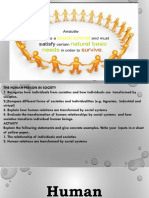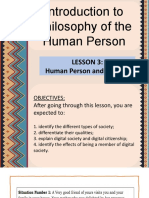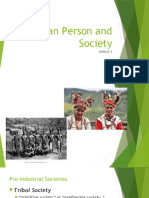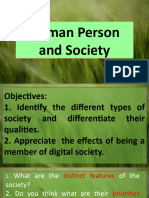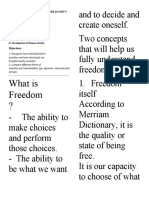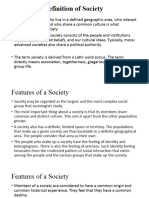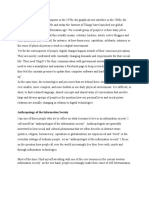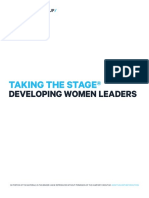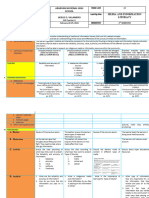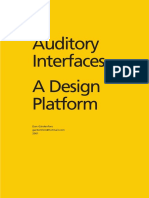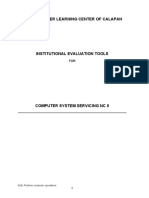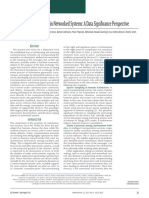Q2-
MODULE 3
HUMAN PERSON AND SOCIETY
�AFTER GOING THROUGH THIS
MODULE, YOU ARE EXPECTED TO:
1. identify the different types of society;
2. differentiate their qualities;
3. explain digital society and digital citizenship;
4. identify the effects of being a member of
digital society.
� MEN -- BY
THEIR NATURE
– ARE
POLITICAL
ANIMALS.
�This ancient saying of Aristotle has never lose
its appeal. Perhaps the reason is that despite
the long course it traversed in the history, it
still capsulizes one of the essential elements
of human nature – human’s endowed
innateness to gather themselves and create a
community where they share their
commonalities and fix differences.
�In this module, learners will understand
how individuals form societies and, in
turn, how does society transform them.
Importantly, learners will be able to
explain how human relations are
transformed by social systems.
� A. PRE-
INDUSTRIAL
SOCIETIES
� A. TRIBAL
SOCIETY
The term “tribe” denotes a group of peoples
living in a primitive setting under a leader or
chief. The term ‘tribal society’ associates it to
other meaning such as “primitive society” or
“preliterate society.” The word ‘tribe’ has
become an important technical term which
pertains to a political unit in a certain territory.
� The term’s use is rooted from Latin which is
associated to the political divisions or orders of
the Roman empire. Tribal societies are small in
scale; bound to their spatial and temporal range
of relations in terms of society, law, and politics;
and possess a moral code, cult, and wide range
of belief system.
�A tribal society is a community of people who
share a common culture, language, and
ancestry, often living closely together in small
groups and relying on traditional customs and
social structures.
� B. FEUDAL
SOCIETY
Feudalism refers to the economic, political, and
social system that prevailed in Europe from
about the ninth to the fifteenth century. Due to
the lack of effective centralized government
during this period, kings and lords granted land
and provided protection to lesser nobles known
as vassals. In return, these vassals swore oaths
of loyalty and military service to their lords.
� A feudal society is a system where people are
divided into classes, with nobles owning land
and granting it to vassals or knights in
exchange for loyalty and service, while
peasants work the land in return for protection.
�B. INDUSTRIAL
SOCIETY
�It is the one which uses advance technology to
drive a massive production industry that will
support a large population. For example, the
United States is an industrial society because a
huge portion of its economy is tied to jobs that
involve machine work, like factory farming or
auto-assembly plants, that has a combination of
machine and human employees to produce
� An industrial society is a society
where the economy is based on mass
production and manufacturing, with
people working in factories and
industries instead of agriculture.
� C. POST
INDUSTRIAL
SOCIETY
� It is marked by a progress from a
manufacturing-based to a service-based
economy. Post industrialization is most
evident in countries and regions that were
among the first to experience the Industrial
Revolution, such as the United States,
western Europe, and Japan.
� A post-industrial society is a society where
the economy focuses more on services,
technology, and information rather than
manufacturing, with many people working in
fields like healthcare, education, and
technology.
� Post-industrial societies are
characterized by:
a. a shift from the production of goods to
the production of services;
b. the replacement of manual laborers
with technical and professional workers
(computer engineers, doctors, and
bankers) as the direct production of
�c. the replacement of practical
knowledge with theoretical knowledge;
d. focusing to the theoretical and ethical
implications of new technologies, which
helps society avoid some of the negative
features of introducing new technologies,
concerning environment and energy;
�e. the development of recent scientific
disciplines—that involve new forms of
information technology, cybernetics, or
artificial intelligence—to evaluate the
theoretical and ethical implications of new
technologies;
f. an emphasis on the university and
polytechnic institutes which produce
graduates who innovate and lead the new
�g. the changing values and norms which
reflects the influences on the society. In an
instance, outsourcing of manufactured goods
changes how members of a society see and
treat foreigners and immigrants. Also, those
individuals previously occupied in the
manufacturing sector find themselves with no
clearly defined social role.
�DIGITAL SOCIETY
AND THE
INFORMATION
AGE
� Digital technologies have wildly affected
our interactions and activity in the 21st
century. They have significantly changed our
way of learning, working and socializing. In
this modern world we rely with the use of
modern technology which has led to
considering the possible outcome for the
society, concerning how we would take part
in interaction, and how we can use these
� Having our heads of digital society in
our minds, we first have to think of the
information society; which are correlated with
the progress and development of digital
information and communication technologies
to the internet at least. Information society
plays a vital role with regards to the
circulation and control of made-up ideas
which affects political, economic, social and
� We can manipulate the phasing of
learning (e.g. free sources) or businesses
(e.g. online selling) without a large sum of
money used as a capital and we can share
our ideas and perspectives to the
international audiences as we connect
beyond.
� WHAT DO WE
MEAN BY DIGITAL
CITIZENSHIP?
� We have said that being a digital
citizen requires active participation online,
not just access and use. In their book “Being
Digital Citizens” (2015) Isin and Ruppert
suggest that if we constitute ourselves as
digital citizens, we have become subjects of
power in cyberspace.
�In the digital age, “what it all means” is in
many ways about balancing these
transformations to create a future that
values connection, ethics, and human
potential over mere efficiency or profit. The
digital age isn't just a period of
technological change; it's reshaping how we
see ourselves and our relationships with
� THE
DISEMBODIED
SUBJECT
� A "disembodied subject" refers to
the idea of a person or identity existing
separately from a physical body. In
simple terms, it’s like when you interact
online or in virtual spaces: your
thoughts, words, or personality are
present, but your physical body is not.
� For example, in social media or
virtual games, people present themselves
through text, images, or avatars. Others
see what you post or say, but they don’t
experience you physically as they would
in face-to-face interaction. You become a
"disembodied subject" in that space—a
presence without a body—since people
�ACTIVITY: IDENTITY
COLLAGE -
REPRESENTING THE
SELF WITHOUT THE
SELF
�Directions: On a short bond paper, gather
a selection of 5-10 images that you feel
represent who you are. These could be
photos you’ve taken, found online, or
created in a collage app. Show creativity
in your choices, with the aim of
expressing unique aspects of yourselves
without showing your face or body.
�• Example images might include: a
favorite place, an object that
represents a passion or hobby, colors
that reflect their mood, symbols,
nature elements, or textures that
evoke certain feelings.
�Arrange these images in a digital collage
format. Tools like Canva, PowerPoint, or
even a simple image editor can work well.
The collage should tell a “story” about
them as a person, using only indirect
visual cues.
� Under the collage, explain the
picture, discussing what each image
represents about you.
�Score Interpretation:
• 18-20: Exceptional understanding and expression of
disembodied identity, with strong engagement in
all aspects of the activity.
• 14-17: Good understanding and representation of
identity, with thoughtful reflection and some
creative depth.
• 10-13: Satisfactory but limited understanding and
representation of identity, with some participation
in reflection.



